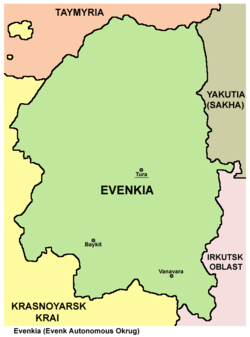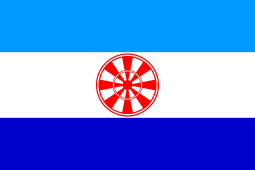Evenk Autonomous Okrug
Evenk Autonomous Okrug (Russian: Эвенки́йский автоно́мный о́круг, Evenkiysky avtonomny okrug; Evenki: Эведы Автомоды Округ, Ēvēde Avtōmōde Okrug), or Evenkia, was a federal subject of Russia (an autonomous okrug of Krasnoyarsk Krai). It had been created in 1930. Its administrative center was the urban-type settlement of Tura. As of 2006, at 767,600 km2, it was Russia's seventh largest federal subject, and the country's least populous: 17,697 (2002 Census).[6]
Evenk Autonomous Okrug | |
|---|---|
| Эвенки́йский Aвтоно́мный Oкруг | |
| Other transcription(s) | |
| • Evenk | Эведы Автомоды Округ |
 Coat of arms | |
 | |
| Country | Russia |
| Federal district | Siberian[1] |
| Economic region | East Siberian[2] |
| Established | 10 December 1930 |
| Capital | Tura |
| Government | |
| • Body | Legislative Assembly |
| • Last Governor | Boris Zolotaryov |
| Area | |
| • Total | 763,197 km2 (294,672 sq mi) |
| Area rank | 7th |
| Population | |
| • Estimate (2007) | 16,979 |
| Time zone | UTC+7 (MSK+4 |
| Official languages | Russian[5] |
In 1999, the governor of Krasnoyarsk, General Alexander Lebed, demanded the okrug recognize the central district government of Krasnoyarsk had authority over it, which the okrug refused to do, causing a power struggle between the central district and the okrug's government.[7]
Following a referendum on the issue held on April 17, 2005, Evenk and Taymyr Autonomous Okrugs were merged into Krasnoyarsk Krai effective January 1, 2007 (some Evenks contested the results, however). Administratively, they are now considered to be districts with special status within Krasnoyarsk Krai; municipally, they have a status of municipal districts (see Evenkiysky District).
Boris Zolotaryov was the last governor of the autonomous okrug.
Administrative divisions

Before 2007, Evenk AO contained three districts:
- Baykitsky District
- Ilimpiyskiy District
- Tungussko-Chunsky District
Demographics
Population
(2002): 17,697.
Vital statistics
| Average population (x 1000) | Live births | Deaths | Natural change | Crude birth rate (per 1000) | Crude death rate (per 1000) | Natural change (per 1000) | |
|---|---|---|---|---|---|---|---|
| 1970 | 13 | 314 | 144 | 170 | 24.2 | 11.1 | 13.1 |
| 1975 | 15 | 254 | 159 | 95 | 16.9 | 10.6 | 6.3 |
| 1980 | 17 | 373 | 167 | 206 | 21.9 | 9.8 | 12.1 |
| 1985 | 22 | 521 | 219 | 302 | 23.7 | 10.0 | 13.7 |
| 1990 | 24 | 514 | 189 | 325 | 21.3 | 7.8 | 13.5 |
| 1991 | 24 | 427 | 221 | 206 | 17.7 | 9.1 | 8.5 |
| 1992 | 24 | 414 | 249 | 165 | 17.5 | 10.5 | 7.0 |
| 1993 | 23 | 297 | 270 | 27 | 13.1 | 11.9 | 1.2 |
| 1994 | 21 | 294 | 257 | 37 | 13.9 | 12.1 | 1.7 |
| 1995 | 20 | 299 | 214 | 85 | 14.8 | 10.6 | 4.2 |
| 1996 | 20 | 269 | 223 | 46 | 13.5 | 11.2 | 2.3 |
| 1997 | 20 | 261 | 202 | 59 | 13.3 | 10.3 | 3.0 |
| 1998 | 19 | 244 | 220 | 24 | 12.7 | 11.4 | 1.2 |
| 1999 | 19 | 251 | 203 | 48 | 13.4 | 10.8 | 2.6 |
| 2000 | 18 | 242 | 214 | 28 | 13.3 | 11.7 | 1.5 |
| 2001 | 18 | 274 | 234 | 40 | 15.3 | 13.1 | 2.2 |
| 2002 | 18 | 263 | 237 | 26 | 14.9 | 13.4 | 1.5 |
| 2003 | 18 | 274 | 215 | 59 | 15.6 | 12.3 | 3.4 |
| 2004 | 17 | 267 | 218 | 49 | 15.4 | 12.6 | 2.8 |
| 2005 | 17 | 283 | 259 | 24 | 16.5 | 15.1 | 1.4 |
| 2006 | 17 | 282 | 236 | 46 | 16.6 | 13.9 | 2.7 |
Ethnic groups
Of the 17,697 residents (as of the 2002 Census) 2 (0.01%) chose not to specify their ethnic background. Of the rest, residents identified themselves as belonging to 67 ethnic groups, including ethnic Russians (62%), Evenks (21.5%), Yakuts (5.6%), Ukrainians (3.1%), Kets (1.2%), 162 Tatars (0.9%), 152 Khakas (0.9%) and 127 Volga Germans (0.7%).
| Ethnic group |
1939 census | 1959 census | 1970 census | 1979 census | 1989 census | 2002 census | ||||||
|---|---|---|---|---|---|---|---|---|---|---|---|---|
| Number | % | Number | % | Number | % | Number | % | Number | % | Number | % | |
| Evenks | 3,721 | 39.3% | 3,474 | 33.7% | 3,207 | 25.3% | 3,239 | 20.3% | 3,480 | 14.0% | 3,802 | 21.5% |
| Yakuts | 713 | 7.5% | 51 | 0.5% | 781 | 6.2% | 822 | 5.1% | 937 | 3.8% | 991 | 5.6% |
| Kets | 14 | 0.1% | 142 | 1.1% | 154 | 1.0% | 150 | 0.6% | 211 | 1.2% | ||
| Russians | 4,675 | 49.4% | 5,975 | 57.9% | 7,732 | 61.1% | 10,400 | 65.1% | 16,718 | 67.5% | 10,958 | 61.9% |
| Ukrainians | 117 | 1.2% | 196 | 1.9% | 254 | 2.0% | 472 | 3.0% | 1,303 | 5.3% | 550 | 3.1% |
| Others | 234 | 2.5% | 610 | 5.9% | 542 | 4.3% | 881 | 5.5% | 2,181 | 8.8% | 1,185 | 6.7% |
References
- Президент Российской Федерации. Указ №849 от 13 мая 2000 г. «О полномочном представителе Президента Российской Федерации в федеральном округе». Вступил в силу 13 мая 2000 г. Опубликован: "Собрание законодательства РФ", No. 20, ст. 2112, 15 мая 2000 г. (President of the Russian Federation. Decree #849 of May 13, 2000 On the Plenipotentiary Representative of the President of the Russian Federation in a Federal District. Effective as of May 13, 2000.).
- Госстандарт Российской Федерации. №ОК 024-95 27 декабря 1995 г. «Общероссийский классификатор экономических регионов. 2. Экономические районы», в ред. Изменения №5/2001 ОКЭР. (Gosstandart of the Russian Federation. #OK 024-95 December 27, 1995 Russian Classification of Economic Regions. 2. Economic Regions, as amended by the Amendment #5/2001 OKER. ).
- Федеральная служба государственной статистики (Federal State Statistics Service) (2004-05-21). "Территория, число районов, населённых пунктов и сельских администраций по субъектам Российской Федерации (Territory, Number of Districts, Inhabited Localities, and Rural Administration by Federal Subjects of the Russian Federation)". Всероссийская перепись населения 2002 года (All-Russia Population Census of 2002) (in Russian). Federal State Statistics Service. Retrieved 2011-11-01.
- "Об исчислении времени". Официальный интернет-портал правовой информации (in Russian). 3 June 2011. Retrieved 19 January 2019.
- Official throughout the Russian Federation according to Article 68.1 of the Constitution of Russia.
- Russian Federal State Statistics Service (21 May 2004). "Численность населения России, субъектов Российской Федерации в составе федеральных округов, районов, городских поселений, сельских населённых пунктов – районных центров и сельских населённых пунктов с населением 3 тысячи и более человек" [Population of Russia, Its Federal Districts, Federal Subjects, Districts, Urban Localities, Rural Localities—Administrative Centers, and Rural Localities with Population of Over 3,000] (XLS). Всероссийская перепись населения 2002 года [All-Russia Population Census of 2002] (in Russian).
- National Geographic. The Book of Peoples. Page 139
See also
- Music of Evenkia
